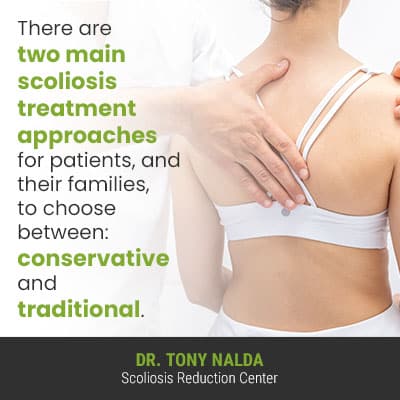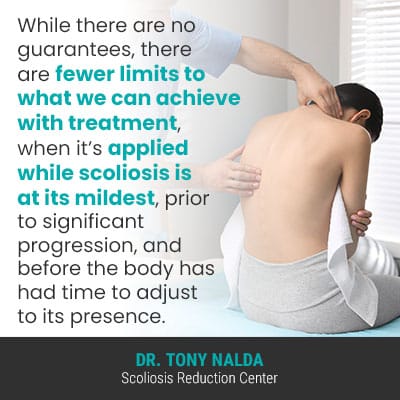Scoliosis is a complex structural spinal condition. While it can’t be cured in the traditional sense, it can be managed and treated effectively by a proactive treatment that’s customized to address the specifics of each patient and their condition type.
While scoliosis is incurable, it is highly treatable, but patients need to be aware that different treatment options have different potential outcomes. While scoliosis can’t be fixed, in the sense of being cured, it can be managed effectively with proactive treatment.
Before we get into the specifics of scoliosis treatment options, let’s talk generally about spinal anatomy and how scoliosis affects spinal health and function.
Scoliosis and the Spine
For a person to be diagnosed with scoliosis, certain parameters have to be met; they have to have an unnatural sideways spinal curvature, with rotation and a minimum Cobb angle measurement of 10 degrees.
The rotational component makes it a 3-dimensional condition as the spine doesn’t just bend unnaturally to the side but also twists from front to back, back to front, and this is an important condition characteristic, especially when it comes to treatment.
Cobb angle is known as the orthopedic gold standard in the assessment of scoliosis and is taken from X-ray images by drawing intersecting lines from the tops and bottoms of the scoliotic curve’s most-tilted vertebrae at the apex of the curve.
The resulting angle is measured in degrees and places conditions on a severity scale of mild to moderate, severe to very severe:
- Mild scoliosis: Cobb angle measurement of between 10 and 25 degrees
- Moderate scoliosis: Cobb angle measurement of between 25 and 40 degrees
- Severe scoliosis: Cobb angle measurement of 40+ degrees
- Very-severe scoliosis: Cobb angle measurement of 80+ degrees
As you can see from the wide range of Cobb-angle degrees, scoliosis is highly variable, so symptoms one person experiences can vary widely from what others might experience, which is why the very nature of scoliosis necessitates a customized treatment approach.

There are three main spinal sections, each with its own natural curve: cervical (neck), thoracic (middle/upper back), and lumbar (lower back).
Each spinal section has its own curvature type, known as kyphosis and lordosis. The cervical and lumbar spinal sections feature lordotic curves that bend inwards, towards the body’s center, while the thoracic spine features a kyphotic curve that bends outwards, away from the body’s center.
The spine’s natural and healthy curves make the spine stronger, allow us to stand upright and practice good posture, and facilitate the even absorption/distribution of mechanical stress incurred during movement; these curves allow the spine to function optimally.
If a condition like scoliosis causes the loss of one or more of the spine’s healthy curves, it can’t function optimally as its biomechanics are disrupted, and the integrity of each spinal curve is dependent on the health of the others.
Another important condition characteristic to understand is that scoliosis is progressive, meaning it’s in its very nature to worsen over time, especially if left untreated or not treated proactively.
So as scoliosis can’t be fixed, as in cured, its progressive nature needs to be counteracted with proactive treatment, but fully understanding the differences between the treatment options available is important. Let’s move on to exploring the modern approach that patients of the Scoliosis Reduction Center® benefit from: conservative chiropractic-centered treatment.
Can Scoliosis be Fixed by a Chiropractor?
Again, scoliosis can’t be fixed, as in cured, but a scoliotic curve can be reduced and managed effectively.
When it comes to the question of whether or not a chiropractor can treat scoliosis effectively, the answer is a general chiropractor will fall short because scoliosis is a highly-complex condition, but a scoliosis-specific chiropractor understands the complexities of the condition and how to treat it, and when combined with other treatment disciplines, chiropractic care can help achieve impressive results.
As mentioned, I treat patients with a conservative chiropractic-centered treatment approach, which is modern and highly effective; our results at the Center speak for themselves.
As a CLEAR-certified scoliosis chiropractor, I know the spine and scoliosis, and I have dedicated my career to rewriting the narrative around scoliosis by educating people on the merits of a nonsurgical approach to treating the condition.
By integrating different condition-specific treatment disciplines such as chiropractic care, in-office therapy, custom-prescribed home exercises, and corrective bracing, I can help patients work towards a curvature reduction on a structural level, use scoliosis-specific exercises (SSEs) to increase core strength, so the spine is optimally supported/stabilized by its surrounding muscles, and when particularly effective on growing spines, corrective bracing can help augment corrective results.
There are a variety of chiropractic techniques and strategies that can be used, and in many cases, gentle and precise chiropractic adjustments can help reposition affected vertebrae back into alignment with the rest of the spine, restoring its natural curves for improved overall health and function.
In addition, SSEs, when prescribed by a scoliosis specialist, can help activate certain areas of the brain for better brain-body communication, body positioning, and postural remodeling.
By relying on a combination of different treatment disciplines, I can apportion them accordingly and make adjustments based on how the spine is responding to treatment: a fully-customized treatment approach that addresses the specifics of each patient and their condition.
So what about the surgical approach to treating scoliosis?
Can Scoliosis be Fixed Without Surgery?

There are two main scoliosis treatment approaches for patients, and their families, to choose between: conservative and traditional.
Under the traditional approach, patients are commonly funneled towards spinal fusion surgery, and while the procedure does have its place in scoliosis treatment, most cases of scoliosis can be treated non-surgically.
While a conservative approach values proactive treatment applied as close to the time of diagnosis as possible, traditional treatment, particularly in cases of mild scoliosis, responds by watching and waiting for signs of further progression.
The issue I have with this approach is that as a progressive condition, we know that virtually every case of scoliosis is guaranteed to worsen over time, at some point, and meanwhile, allowing an unnatural spinal curve to progress unimpeded is wasting valuable treatment time, not to mention complicating the treatment process in the future.
While there are no guarantees, there are fewer limits to what we can achieve with treatment when it’s applied while scoliosis is at its mildest, prior to significant progression, and before the body has had time to adjust to its presence.
Just as all surgeries come with their share of risks and potential side effects, spinal fusion is no exception, and if spinal fusion is unsuccessful, there is no recourse other than subsequent surgeries.
There are different types of spinal fusion, but commonly, the procedure involves fusing together the most-tilted vertebrae of the curve into one solid bone so movement (progression) is eliminated in the area, but many patients post-surgery are disappointed at the cost: reduced spinal flexibility and range of motion, sometimes leading to activity restrictions.
So, can scoliosis be fixed without surgery? Not fixed (no treatment can cure scoliosis), but in many cases, it most certainly can be treated successfully and managed effectively without surgery.
Conclusion
So can scoliosis be fixed? Not in the traditional sense of being cured, because of its progressive nature, but it can be managed and treated effectively through proactive and customized treatment.
Here at the Scoliosis Reduction Center®, my patients benefit from access to multiple forms of scoliosis-specific treatment under one roof.
Although there are never treatment guarantees, through a customized combination of scoliosis-specific chiropractic care, in-office therapy, custom-prescribed home exercises, and corrective bracing, I can help impact the condition on multiple levels for the best potential results.
For those recently diagnosed with scoliosis, I encourage researching all available treatment options, as different treatment approaches offer potential results that can have far-reaching effects and determine the quality of life with the condition.
While a traditional approach tends to funnel patients towards spinal fusion surgery due to its reactive response to the condition, a modern conservative chiropractic-centered treatment approach values a proactive response, customized treatment plans, and integrating multiple treatment disciplines so conditions are impacted on every level.
Here at the Center, I spend a lot of time discussing the pros and cons associated with the different treatment approaches with patients, and their families, to ensure that treatment expectations are aligned with the reality of their potential outcomes, so don’t hesitate to reach out to us here for further guidance and support.





